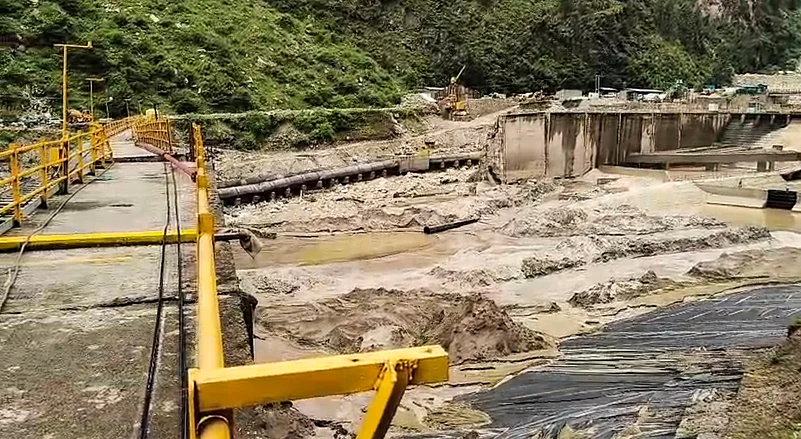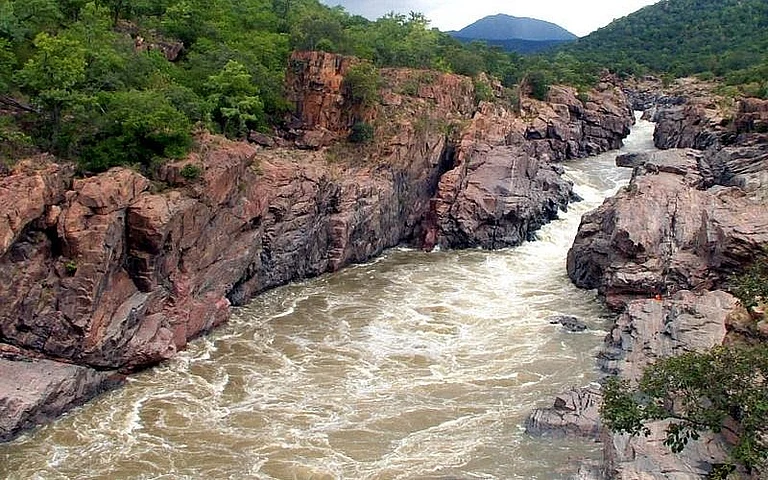
Dams turning into water bombs in Himachal during disasters.
Even smaller hydro power projects cause ecological destruction.
RTIs help concerned citizens gain insight into problems, solutions.
A middle-aged man with his face half hidden under a safety helmet fitted with a flickering torch breathlessly declares in a panicked voice: “Bhaiyo… Malana Dam fatt gaya hai! Nadi, nalluh se door raho… Apni jaan bachao!” (Brothers, the Malana Dam has burst! Stay away from rivers and mountain streams… save your lives!)
His words echo like an alarm, carrying a message of urgency, cutting through the chaotic noise of a torrential water stream.
A moment later, a large volume of gushing water bursts from the dam—a concrete gravity reservoir at an elevation of 2,543 meters, 3 km downstream from the iconic village of Malana—wreaking havoc in the ecologically fragile valley. Several houses, farmland and heavy infrastructure including roads, bridges, footbridges and water supply schemes get washed away in the massive flood.
“More than 1,60,000 cubic meters of (flash flood) water caused the Malana dam to burst after a terrifying cloudburst and relentless monsoon rains in the higher catchments on August 1, 2024. It swept away everything downstream. Fields, trees, vehicles, machinery, temples, bridges, etc., looked like they were floating in a shocking trial of destruction and damage,” recalls Manshi Asher, an environmental justice activist working in the Himalayan region.
Asher says that as per official reports, even the 2023 flood in Himachal Pradesh was worsened by the release of dam water, prompting allegations of negligence against hydropower operators.
Now, an RTI request filed by Sumit Mahar of the Himdhara Collective has made new revelations about safety issues linked with the (mis)management of dams.
Just months earlier in 2023, Himachal Pradesh had suffered the worst effects of natural calamities, leaving more than 500 people dead and hundreds homeless or landless. Kullu became the epicentre during the deluge after massive rains, cloudbursts, flash floods and landslides. Affected families lost their shops and businesses, their main vocations. The loss to public infrastructure was estimated at Rs 10,000 crore.
Yet again this year, relentless rain and cloudbursts have wreaked havoc across the Seraj area of the Mandi district and parts of Kullu, where there are several mega- as well as smaller hydropower projects. Shocking visuals from Kullu show the Malana-I Hydropower Project site collapsing amid flash floods that effortlessly swept away heavy machinery.
A sudden water surge triggered by the collapse of the Malana-I hydel project’s cofferdam unleashed a flash flood on August 2, 2025, sweeping away heavy machinery, rock breakers, dumpers and other vehicles. The disaster crippled the region’s connectivity, as the sole bridge linking Malana village to the outside world was washed away, cutting it off from all access.
Dozens of houses were razed; agricultural land and apple orchards were damaged and left in ruins by flowing debris and boulders. Parked vehicles were washed away in the fury.
Environmentalists attribute frequent disasters and extreme weather events, which are the hallmarks of climate change, as the primary factors behind the devastation. This also means that the losses caused to public and private infrastructure is attributable to human-induced activities.
Before the state government sanctioned a series of hydropower projects in districts like Kullu, Shimla, Chamba, Mandi, Kinnaur and Lahaul-Spiti to harness the state’s power potential and started using steep-cutting of hillsides, or blasting to make tunnels, the flash flood-related destruction had never been of the magnitude seen of late, says Shashi Kant, a Kullu-born journalist.
Last week, the Supreme Court, treating a petition as a PIL, made some of the strongest observations ever on the issue.
The Bench observed that humans, not nature, are responsible for phenomena such as continuous land slides along mountainsides blocking roads and leading to the collapse of houses and buildings. The court said the major causes of destruction in the state are hydropower projects, the four-laning of roads, deforestation and multi-storey buildings.
A state Energy Department inquiry into the collapse of the Malana-I, Malana-II and Parvati projects, which severely hit the Parbati Valley and Malana’s downstream areas in the July-August 2023 flash floods, has exposed serious lapses in dam management and a shocking indifference by project companies towards the safety of nearby residents. There is neither a proper early warning system nor a mechanism to minimise the damage.
The dam has twice exceeded its storage capacity. With no auxiliary spillway in place to handle emergencies like jammed floodgates, the risk of a catastrophic breach looms dangerously over the region.
The inquiry report was shared with Sumit Mahar in response to his RTI request, and it said, “No doubt cloudbursts are unpredictable and unstoppable events, but we can manage to minimise the damage/losses and to safeguard valuable lives and infrastructure.”
It further said, “Both the projects Malana-I and Malana-II need to improve monitoring and the Early Warning System for such events. The projects must also strive hard to have a comprehensive network of weather RADAR, automatic rain gauges, and, most importantly, the river discharge sensors for real-time data acquisition and forecasting accuracy.
The findings also pointed to the project promoters’ negligence in dredging the river to remove silt and debris, ignoring clear directions of the Energy Department. This lapse increases the risk of flash floods during heavy rains, threatening villages and critical infrastructure downstream.
Sumit Mahar, an environmental activist who has studied the impact of hydel projects and dams in detail, says, “If we closely study the pattern of flash floods and environmental damage , it is not just a question of saving Himachal Pradesh from disasters and the adverse impact of hydel projects or dams, but [of saving] the entire Himalayas.”
The RTI analysis of the site inspection report reveals widespread safety and regulatory failures, a non-functional early warning system, a missing dam break analysis and other significant lapses.
The floodgates of the Malana-II project failed during the cloudburst, causing the water level in the storage reservoir to rise and subsequent destruction downstream after the collapse.
Forget how much destruction mega projects can cause; small projects also contribute to the severe ecological risks. These have also led to serious natural calamities, destabilisation of mountains resulting in landslides and drying up of rivulets and drinking water sources. Thousands of forest trees were felled to make way for these small projects.
The Nathpa Jhakri hydel project (1500 MW)—one of the most significant hydel projects, built at a cost of Rs 8,187 crore in the 1990s after diverting Satluj water through a 27.4 km headrace tunnel—has also remained controversial for severe environmental damages and felling of hundreds of forest trees. Other projects, such as Karcham Wangtoo (1091 MW) and upcoming projects like Jangi Thopan Powari (804 MW), are facing stiff opposition from tribals and green activists in Kinnaur. The project is envisaged to have a concrete gravity dam 48 meters high from the riverbed level on the Satluj.
“The projects have destabilised the hills and triggered frequent landslides, besides resulting in ecological changes in Kinnaur’s cold desert region. There is a visible impact on the agricultural activities, traditional cropping pattern, fruit crops, and livelihood,” says environment activist SK Negi.
Several private sector hydropower projects in the Kinnaur district face opposition due to concerns about the region’s ecological fragility, potential for landslides and impact on livelihoods. The Kashang Hydroelectric Project and others on the Sutlej River and its tributaries have been criticised for their potential to cause geological instability, deforestation and displace communities.
In its last meeting, the state Cabinet decided to invite fresh proposals for 172 more small hydropower projects. Twenty-two other projects above five MW were also cleared. The state government is, therefore, going full steam ahead with hydel projects, perhaps seeing them as a revenue spinner.
Chief Minister Sukhwinder Singh Sukhu has put the brakes on handing over three hydel power projects to the Sutlej Jal Vidyut Nigam (SJVN) Ltd, insisting that the shares of free power (royalty) be raised (to 12, 18 and 30 per cent )and the project handed to the government after 40 years.
Last month, the Supreme Court allowed the government to get 18 per cent free power from the Karcham-Wangtoo hydroelectric project, which is operated by JSW Hydro Energy Limited, in Kinnaur.
Sumit Mahar cites a 2024 investigation by German non-profit CORRECTIV that 3.8 million carbon credits from Indian projects, mostly from four Himachal hydropower projects, failed to deliver the promised offsets. Despite being branded as “clean energy”, these dams and projects have come under fire for worsening the 2023 flood.
“As the climate crisis deepens, hydropower in the Himalayas is proving to be a dangerous illusion of green energy,” he says.
































